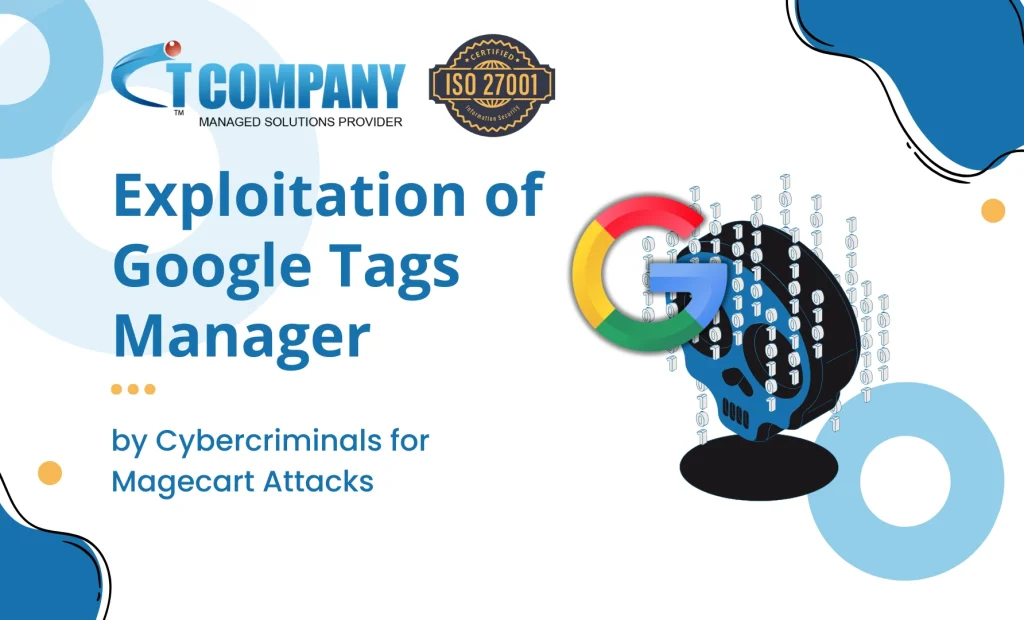
The sun had barely risen when Jane, a small business owner running a boutique online store, opened her laptop to check sales. She had just launched a massive marketing campaign to boost her online presence. However, what she discovered instead was a nightmare. Her checkout pages, designed to capture customer payment details, had been hijacked. The attackers were using the very tools Jane trusted to run her business—Google Tag Manager (GTM)—to collect sensitive data from her customers. With a click of a button, cybercriminals had infiltrated her site, siphoning off payment card details.
This scenario isn’t just a one-off. Cybercriminals worldwide are increasingly exploiting GTM in eCommerce sites like Jane’s, exploiting vulnerabilities that leave businesses exposed. Let’s dive into how they do it, how it impacts online businesses, and what steps can be taken to prevent it.
Table of Contents
ToggleWhat is Google Tag Manager (GTM)?
Before we get into the dangers, it’s essential to understand what Google Tag Manager is. GTM is a tag management system (TMS) that allows marketers to manage JavaScript and HTML tags for tracking and analytics on websites. It simplifies the process of deploying marketing scripts without needing to update code directly on the website.
For many eCommerce businesses, GTM is an indispensable tool. It can track user behavior, measure conversions, and integrate with other platforms. However, this very functionality has become the target of cybercriminals.
How Cybercriminals Exploit GTM in Megacart Ecommerce
Cybercriminals exploit GTM in two primary ways:
- Malicious Tag Injection: Attackers insert rogue tags into the GTM container. These tags collect data entered by users during the checkout process, such as credit card numbers, addresses, and other personally identifiable information (PII). Once the data is captured, it is sent to a remote server controlled by the attackers.
- Cross-Site Scripting (XSS): In this scenario, cybercriminals inject malicious JavaScript into the GTM container, which then executes on users’ browsers. This script can steal cookies, session tokens, or even manipulate the checkout process, redirecting payment details to the attacker’s server.
The use of GTM as a backdoor is particularly harmful because it often bypasses traditional security defenses. GTM is typically trusted by website owners and often goes unchecked, making it an ideal target for cybercriminals.
The Impact on Megacart Ecommerce Stores
Megacart eCommerce stores, often handling large volumes of transactions, are prime targets for such attacks. These platforms host multiple vendors and transactions, making it more challenging to monitor for malicious activity.
A Surge in Attacks
In 2023 alone, there was a 400% increase in eCommerce cyberattacks targeting vulnerabilities in third-party tools like GTM. The reason is simple—cybercriminals know that eCommerce platforms rely heavily on third-party services for user tracking and advertising. Once they gain control of GTM, they have access to a wealth of sensitive information.
For businesses, the consequences are devastating. Beyond the immediate financial losses due to stolen customer data, there are long-term reputational damages. A breach can lead to the loss of customer trust, penalties, and legal ramifications.
Financial Losses
According to a report by the Ponemon Institute, data breaches in eCommerce businesses can cost an average of $3.86 million per incident. This figure doesn’t account for the legal fees, regulatory fines, or brand damage that follow.
For customers, their stolen data can be used in identity theft, credit card fraud, or even sold on the dark web. This creates a ripple effect where both businesses and consumers bear the financial brunt of such attacks.
Why GTM is an Attractive Target for Cybercriminals
There are several reasons why GTM is such a vulnerable attack vector for cybercriminals:
1. Wide Adoption
GTM is widely used across all eCommerce platforms. Its simplicity and convenience make it a popular choice. However, this wide adoption also means that once hackers discover a vulnerability, they can exploit it across a vast number of sites.
2. No Direct Code Changes
Using GTM, marketers can add and remove tags without needing developer intervention. This flexibility means that attackers can inject malicious tags without being detected by developers or security tools that monitor the website’s core code.
3. Trust and Lack of Scrutiny
GTM is often seen as a trusted tool, and businesses rarely inspect its content once set up. This trust makes it an appealing target for attackers, who can hijack it without raising suspicion.
4. Difficult Detection
Malicious GTM tags are often difficult to detect because they blend seamlessly into the regular operations of the website. Since GTM runs on the client side (user’s browser), businesses may not be able to track unauthorized actions until it’s too late.
Case Study: The Megacart Breach
In early 2024, a well-known eCommerce marketplace that hosted thousands of small vendors experienced a major data breach. Cybercriminals had injected malicious JavaScript into the GTM container used across the platform. The attackers intercepted payment card details entered during checkout and sent them to their server.
The breach resulted in over 100,000 compromised accounts, with stolen data eventually being sold on the dark web. The total financial damage, including the cost of customer notification and legal fees, exceeded $5 million. The company faced not only the immediate financial loss but also a significant drop in customer confidence, leading to reduced sales.
How to Protect Your Megacart Store from GTM Exploits
While the risks are clear, the good news is that businesses can take steps to protect themselves.
1. Limit Access to GTM
Restrict access to GTM to only trusted and trained personnel. Implement strong authentication methods, such as two-factor authentication (2FA), to secure your GTM account.
2. Regular Audits and Monitoring
Regularly audit the tags in your GTM container to ensure no malicious code has been injected. Implement real-time monitoring for suspicious activity across your website and checkout process.
3. Security Tools Integration
Integrate security tools that scan and monitor JavaScript execution across your site. Solutions like Web Application Firewalls (WAFs) can prevent unauthorized script injection.
4. Educate Your Team
Ensure that your development, marketing, and IT teams are aware of the risks associated with GTM. Training them to spot potential vulnerabilities and to follow best security practices can prevent many attacks.
5. Stay Updated
Ensure that your eCommerce platform and any third-party tools are regularly updated with the latest security patches. Attackers often target known vulnerabilities that have not been addressed by businesses.

Conclusion
Cybercriminals are increasingly turning to tools like GTM to exploit vulnerabilities in eCommerce platforms, with devastating consequences for businesses and their customers. The ability to easily inject malicious tags or scripts into GTM gives attackers a powerful backdoor to steal sensitive data.
By taking proactive measures, such as limiting access, regularly auditing tags, and integrating security tools, businesses can protect themselves from these evolving threats. In today’s digital landscape, staying one step ahead of cybercriminals is not optional—it’s essential to safeguard both your business and your customers’ trust.




